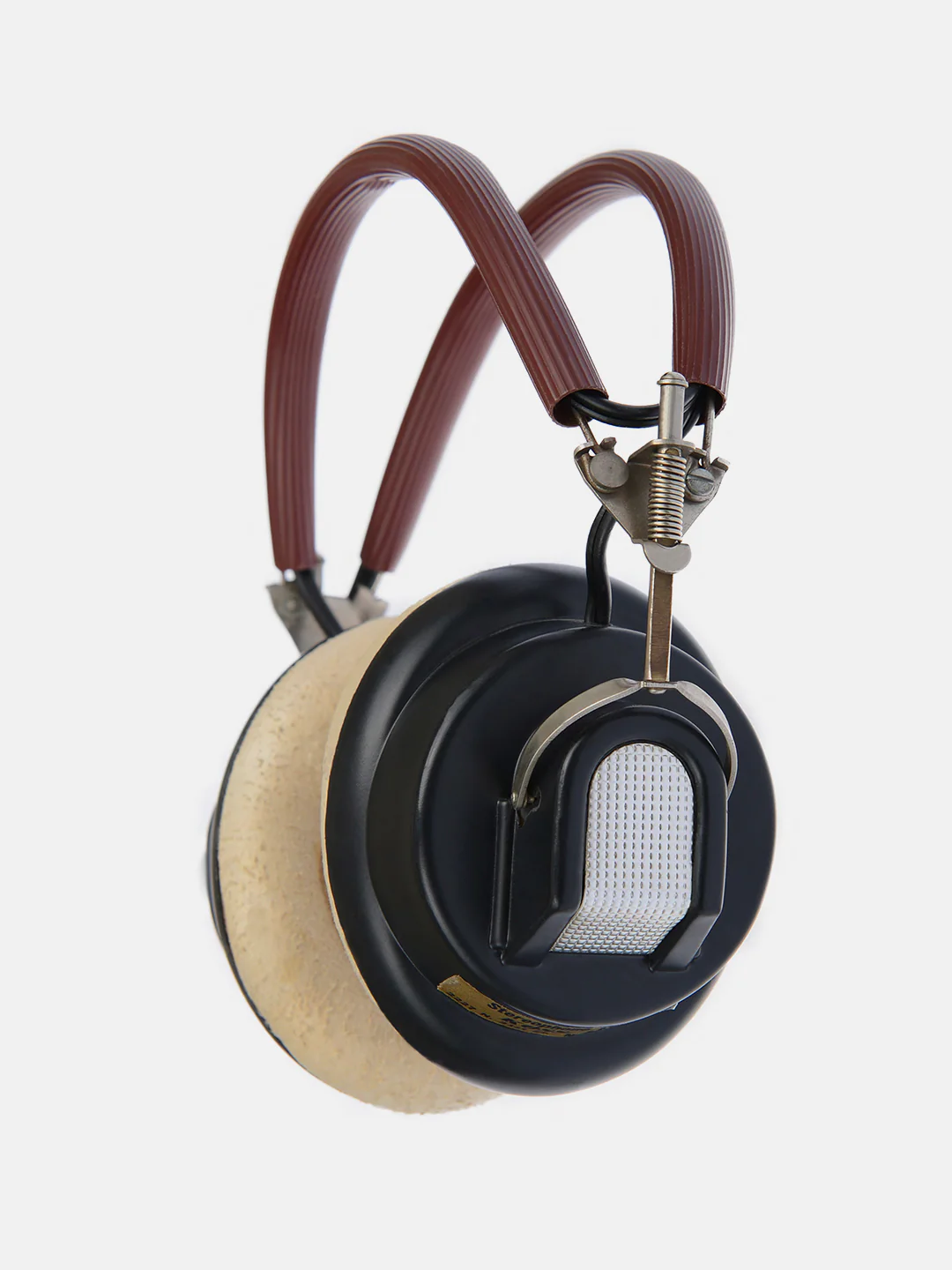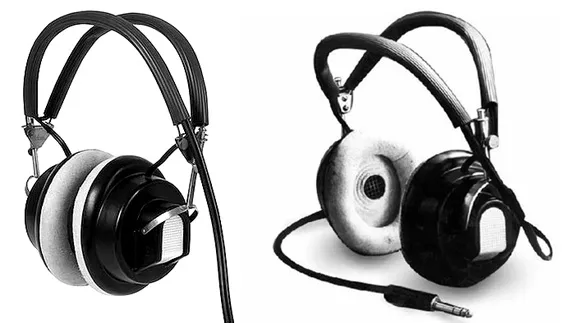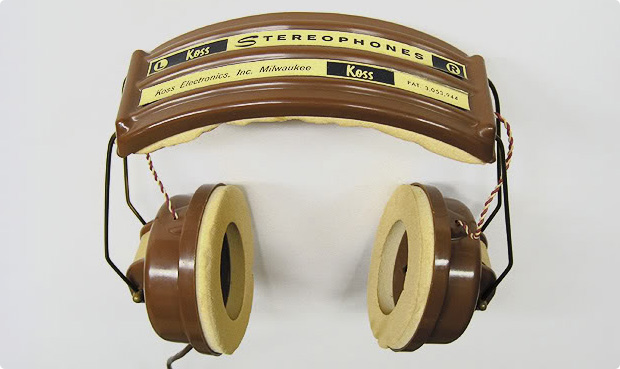Hi-Fi Hall of Fame
2024 Inductee
Koss SP/3 Stereo Headphones

Introduction
In 1958, the Hi-Fi landscape was forever changed with the invention of the Koss SP/3, the world’s first stereo headphone.
Headphones in various forms had been around since the 1880s. They were used by telephone operators, military personnel, and other folks to improve audio clarity, to free up their hands, and to keep conversations private, but they weren’t generally used for listening to music.

John Koss was a Milwaukee businessman who operated a television rental business for local hospitals. He was also a jazz musician and, perhaps driven by a desire to replicate the immersive experience of live music, partnered with engineer Martin Lange, Jr. to develop a portable stereo phonograph with side wing speakers.

Koss and Lange unveiled their new phonograph at an audio show in Milwaukee, but the star of the show that day wasn’t the phonograph itself; it was the “accessory headphones” that were bundled with the system. Those headphones were the Koss SP/3.

The headphones were initially intended to demonstrate the high fidelity stereo sound of the phonograph and the “private listening” aspect of headphones, but the SP/3 unexpectedly stole the spotlight with their novelty and sound quality. Those first models were little more than tiny loudspeakers mounted in plastic shells and held on the head by a military style headband, but the people at the show loved them!

Based on that experience, Koss and Lange started a new business focusing on stereo headphones and of course became very successful: Koss headphones dominated the headphone market for many years. Let’s take a look at the headphones that started it all, the Koss SP/3 “Stereophone”.
Koss SP/3 Design and Performance
Before the SP/3, headphones were primarily used for professional applications, not for personal listening. They were best suited for voice communications, and not for music. The Koss SP/3 changed all of that. The SP/3 operated in stereo, which was still quite new at the time. They were designed for music, and were engineered to have a wide, smooth frequency response so listeners could enjoy every note.
The SP/3 employed an open back design, a novelty at the time, to offer a wider soundstage and more natural sound reproduction compared to closed-back headphones. This spaciousness became a signature of Koss headphones for years to come.
While not boasting high-tech components by today’s standards, the SP/3 featured some innovative features for its time. The privacy switch allowed users to enjoy stereo sound without disturbing others, a crucial aspect for personal listening in shared spaces. The lightweight, plastic construction made them portable and comfortable, a stark contrast to the bulky, metal headphones of the era.

The SP/3’s success fueled the burgeoning personal audio market and paved the way for the emergence of headphones, portable radios, and portable cassette players in the 1960s, 70s and 80s. The SP/3 also transcended its role as a product, becoming a cultural icon. Its image adorned album covers and pop culture references, solidifying its place in audio history.


Although the SP/3 was groundbreaking, it wasn’t without limitations. Its open-back design offered little noise isolation, and its sound signature may not be considered high fidelity by today’s standards. Koss and Lange went back to the drawing board and developed the Koss SP/3X, with better sound quality, improved aesthetics, and a more comfortable fit.


Despite its limitations, the Koss SP/3’s historical significance and cultural impact remain undeniable. It’s release marked a pivotal moment in personal audio history, forever changing the way that people listen to music.

Legacy of the Koss SP/3
While the Koss SP/3 itself is no longer in production, its legacy lives on. It inspired countless headphone designs and continues to be revered by audio enthusiasts for its pioneering spirit and impact. Koss, as a brand, remains synonymous with clear, natural sound and affordability, values instilled by the revolutionary SP/3.
Buoyed by the success of the SP/3, Koss immediately began developing new models. In 1960 they released the SP/3X, which was fitted with better drivers to improve sound quality and better earpads to improve comfort.

1962 saw the release of the Koss Pro/4 headphone, which was a significant improvement over the SP/3. It was a closed back design, with a new driver for superior sound quality. The Pro/4 proved to be a real fixture in the Koss line-up; the design has been revised many times over the years, and in fact you can buy the Pro 4AA model today, more than 60 years after the release of the original model!


In 1968, Koss released the ESP/6, the world’s first self-powered electrostatic headphone. Electrostatic headphones employ an ultra lightweight conductive diaphragm that is moved by applying an electric charge. Electrostatic speakers produce a remarkably fast and accurate sound compared to conventional dynamic headphone drivers.

In 1974, Koss released the HV/1A. The first dynamic headphone capable of reproducing all 10 audible octaves, the HV/1A paved a new course in personal listening. The unmatched sound, and modern dynamic speaker elements found in Koss Headphones today are a direct evolution from the legendary HV/1A.

In 1984, the acclaimed Koss “Porta Pro” headphone set performance and comfort standards for portable personal listening worldwide. Designed for those with a refined ear for music, the Porta Pro continues to be one of the most popular headphones around the world.

In 1989, before Bluetooth and Wi-Fi were widely available, infrared light was sometimes used for wireless connectivity. The Koss JCK/300 cordless headphone set the standard for infrared wireless headphones. By developing a new transmitter that delivered four times more power than conventional infrared headphone systems, Koss cut the cord and changed personal listening forever.

In 1990, Koss introduced the revolutionary ESP/950 electrostatic headphone. The ESP/950’s breakthrough design incorporated electrostatic transducers with ideal mechanical damping. The sound is virtually distortionless due largely to its ultra-thin (1.5 micron) diaphragms.

Since then, Koss has released a number of modern headphones and earbuds to fit every preference and budget. If you’d like to read the full history of the Koss company, and read about many of these products, please visit their website:
Induction to the Hi-Fi Hall of Fame
The Koss SP/3 headphones hold an important place in audio history, and their induction into the Hi-Fi Hall of Fame is well justified for three reasons.
First, in 1958, the SP/3 weren’t just a pair of headphones, they changed the way that people experience music. Prior to this, listening was primarily a communal experience through speakers. The SP/3 opened the door to a private world of audio enjoyment.
Second, the SP/3’s success sparked a boom in the development and production of headphones for music listening. Their popularity paved the way for the vast headphone market we see today. The SP/3’s success influenced countless headphone manufacturers and models that followed.
Third, the great commercial success of the Koss SP/3 propelled the Koss company to become a flourishing company that went on to produce many great headphones. KOSS is still making great headphones today and they continue to sell many models that are based on those legacy designs.
For these reasons, the Koss SP/3 is inducted into the Hi-Fi Hall of Fame.
